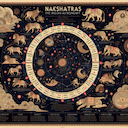Introduction to Nakshatra
Nakshatra, also known as lunar mansions, are one of the foundational elements in Vedic astrology. These are 27 divisions of the sky, each associated with specific stars, and play a crucial role in understanding the celestial influences on an individual. The concept of Nakshatras predates the use of the zodiac signs and offers deeper insights into personality traits, behaviors, and life events.
The Essence of Nakshatra
The Nakshatras are not merely 27 divisions of the sky but are deeply rooted in mythology and spiritual significance. Each Nakshatra is governed by a ruling deity, symbol, and has specific characteristics that influence the planets residing in them. The study of Nakshatras provides a more nuanced understanding of astrological influences than the broader strokes of the zodiac signs.
Historical Context and Evolution
The knowledge of Nakshatra has been passed down through generations, often shrouded in mystery and esoteric teachings. Ten to fifteen years ago, finding comprehensive information on Nakshatras was challenging. Even ancient texts like the Parashara Horasastra provided only fragments, leaving much of the knowledge to be rediscovered or interpreted.
Personal Journey of Exploration
The path to understanding Nakshatra often involves personal initiative and deep observation. For example, by observing the moons daily transit through the Nakshatra over 12 lunar cycles (one year), one can start to perceive the energy and influence of each Nakshatra. This observational approach, combined with disciplined practices and a holistic lifestyle, forms the basis of a deep understanding of Nakshatras.
Fundamental Practices for Studying Nakshatras
To genuinely study Nakshatra, one must adopt certain fundamental practices:
Adopt a holistic lifestyle, including the right diet, posture, and speech.
Focus on grounding practices and discipline to center oneself.
Engage in observational studies, noting the moons transit and its effects.
The Importance of Basics
In ancient times, students would spend years mastering the basics before diving into advanced knowledge. For instance, Vedic disciplines would involve extensive training in proper posture, speech, and understanding the fundamentals before moving on to more complex studies like Nakshatras.
Mythological Significance
Mythology plays a crucial role in understanding Nakshatra. For example, Rohini is considered the favorite Nakshatra of the moon, symbolizing beauty and allure due to its association with Venus. Understanding the mythological stories and their symbolic meanings provides deeper insights into the nature of each Nakshatra.
Rohini Nakshatra
Rohini, associated with Venus, represents beauty, fertility, and creativity. It is often considered auspicious for artistic endeavors and activities related to beauty and aesthetics. The mythology around Rohini emphasizes its nurturing and captivating qualities.
Pushya Nakshatra
Pushya, symbolized by the udder of a cow, represents nourishment and nurturing. It is considered highly auspicious and is associated with growth, prosperity, and spiritual enlightenment. The energy of Pushya is slow and steady, emphasizing stability and support.
Interpreting Nakshatras in Modern Context
While traditional interpretations of Nakshatras are deeply rooted in mythology and ancient practices, applying them in the modern context requires a nuanced understanding. For instance, Ashwini Nakshatra, associated with healers, can be interpreted as a call to holistic healing rather than just conventional medicine.
Ashwini Nakshatra
Ashwini, symbolized by the horse, represents speed, agility, and the power of healing. Traditionally associated with the Ashwini Kumaras, the celestial healers, this Nakshatra emphasizes the importance of quick and effective remedies. In modern times, it can be seen as a call to holistic and natural healing practices.
Understanding Dualities
Many Nakshatras have dual aspects that can manifest in positive or negative ways depending on the context and individual. For example, Vishakha Nakshatra, associated with determination and focus, can also lead to obsession if not balanced properly. Understanding these dualities is crucial for accurate interpretation.
Phonetics and Numerology in Nakshatras
Phonetics and numerology play a significant role in the study of Nakshatras. Each Nakshatra is associated with specific sounds and numbers that influence their characteristics and impact. For instance, Swati Nakshatra, related to the sound Ra, emphasizes movement and flow, reflecting its airy nature.
Swati Nakshatra
Swati, symbolized by the young sprout swaying in the wind, represents independence, flexibility, and self-confidence. The phonetic sound Ra associated with Swati signifies movement and dynamism, highlighting its airy and free-spirited nature.
Role of Numerology
Numerology offers another layer of understanding Nakshatras. For example, the number associated with Rohini Nakshatra is 4, representing stability and grounding. This numeric association helps in understanding the foundational qualities of the Nakshatra.
Applying Nakshatra Knowledge
To effectively apply Nakshatra knowledge, one must integrate it into daily life and practices. This involves observing the moons transit, understanding the energies of the Nakshatras, and aligning activities accordingly. For instance, planning travel or nature-related activities during the transit of Rohini Nakshatra can be highly beneficial.
Practical Applications
By understanding the specific energies of each Nakshatra, one can make informed decisions in various aspects of life, such as health, career, relationships, and spiritual practices. This holistic approach ensures that ones actions are in harmony with the cosmic energies.
Holistic Living
Adopting a holistic lifestyle is essential for effectively studying and applying Nakshatra knowledge. This involves maintaining a balanced diet, practicing grounding exercises, and staying connected to nature. A holistic approach ensures that one is in tune with the natural rhythms and energies of the universe.
Conclusion
The study of Nakshatras offers profound insights into the cosmic influences on human life. By understanding the mythological, phonetic, and numerological aspects of Nakshatras, one can gain a deeper appreciation of their significance. Integrating this knowledge into daily practices and adopting a holistic lifestyle ensures that one is aligned with the cosmic energies, leading to a more harmonious and fulfilling life.
```




































